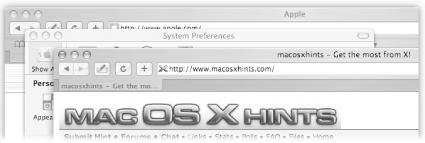What would the Mac be without its glorious, overlapping, drop-shadowed windows?
Unix, that’s what.
In any case, mastering the many wonders of the Mac OS X window is a key survival skill.
Minimizing windows is one of OS X’s more compelling visual tricks. With a simple click of the yellow button, the active window shrinks down and places itself in your dock, ready for future use with the click of a mouse.
But what if you’ve minimized 15 different Safari windows to the Dock, and decide you want them all back? It’s rather annoying to click 15 times just to get your windows back.
Luckily, there’s a fast way out: just hold down the Option key before you click any of the minimized windows, and they’ll all expand into a nicely organized bunch on your desktop.
When you find yourself with several open windows in one program, especially in the Finder, don’t waste time trying to close them individually. Instead, Option-click the red close button at the top left of any open window. Presto! All windows close at once. (That is, except in Word 2004; Microsoft marches to a different drummer.)
Suppose you’re writing a training manual about a piece of software. As you write up your witty little descriptions of the elements of some dialog box, you may find it frustrating that your word processor’s own window is covering up what you’re trying to describe.
That’s precisely when you should use the
-key trick. By pressing
as you drag their title bars, you can move background windows without bringing them to the foreground. (Make sure, however, that you don’t drag a window by its name—anywhere else along the title bar is fine.)
For efficiency’s sake, sometimes you want to bring up all open windows of one program. Unfortunately, as many Mac OS 9 veterans quickly discover, clicking in the window of a Mac OS X program brings only that window forward, leaving the program’s other windows in the background (see Figure 1-6).
If you use
-Tab to switch programs, however, or if you switch by clicking a program’s Dock icon, all of the program’s windows come forward.
Alternatively, you can install a shareware program like DragThing (Section 13.3), which includes a setting that brings “all windows forward” as the preferred behavior when you click an individual window.
You may have noticed an intriguing option on the Appearance panel of System Preferences, something called “Scroll to here.”
Ordinarily, when you click in the scroll bar track above or below the gelatinous handle, the window scrolls by one screenful. But if you turn on “Scroll to here” mode, when you click in the scroll bar track, the Mac considers the entire scroll bar a proportional map of the document and scrolls precisely to the spot you clicked. That is, if you click at the very bottom of the scroll bar track, you see the very last page. (In general, this feature works only in Cocoa programs; see Sidebar 4.2.)
Here’s another tip: no matter which scrolling option you choose in the General panel, you can always override your decision on a case-by-case basis by Option-clicking in the scroll bar track. In other words, if you’ve selected the “Scroll to here” option, you can produce a “jump to next page” scroll by Option-clicking in the scroll bar track.
Even that’s not the end of the Option-key magic:
If you’re trying to read something carefully and slowly, you can slow down the scrolling. If you hold Option while dragging the scroll bar handle, the window shifts smoothly as you drag rather than turbo-scrolling one screen at a time. (This, too, works only in Cocoa programs.)
Conversely, Option-clicking the up or down scroll arrow speeds up scrolling, shifting by a page at a time instead of a line at a time. (Yes, yes, that’s what the Page Up and Page Down keys are for, but when you’re already manipulating these scroll buttons with the mouse, it’s nice to be able to switch quickly back and forth between line scrolling and page scrolling.) This trick works in all Mac OS X programs, Cocoa or not.
In System Preferences, the General pane offers to “Place scroll arrows” either together at the bottom (or left) of the scroll bar, or split up, appearing at opposite ends of the scroll bar. Both settings can lead to extra mousing around.
The ideal arrangement, of course, is to have both scroll arrows at both ends of the bar, as shown in Figure 1-7.
Figure 1-7. Scroll bar utopia. To return to the standard arrows, select one of the existing scroll bar options in the General panel of System Preferences. Or, if you like, repeat the Terminal command described in this hint, replacing DoubleBoth with either Single (top and bottom single arrows) or DoubleMax (double arrows at the bottom).
To create this effect, open Terminal (Section P.3.5.3). At the prompt, type this:
defaults write "Apple Global Domain" AppleScrollBarVariant DoubleBoth
and then press Enter. (See Section P.3.5.4 for more on the defaults command.)
The next time you launch any program, you’ll find that its scroll bar buttons are nestled, in pairs, at both ends of the scroll bars.
Get Mac OS X Power Hound, Second Edition now with the O’Reilly learning platform.
O’Reilly members experience books, live events, courses curated by job role, and more from O’Reilly and nearly 200 top publishers.



